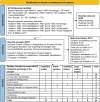Gaming Technology for Pediatric Neurorehabilitation: A Systematic Review
- PMID: 35155305
- PMCID: PMC8832052
- DOI: 10.3389/fped.2022.775356
Gaming Technology for Pediatric Neurorehabilitation: A Systematic Review
Abstract
Introduction: The emergence of gaming technologies, such as videogames and virtual reality, provides a wide variety of possibilities in intensively and enjoyably performing rehabilitation for children with neurological disorders. Solid evidence-based results are however required to promote the use of different gaming technologies in pediatric neurorehabilitation, while simultaneously exploring new related directions concerning neuro-monitoring and rehabilitation in familiar settings.
Aim of the study and methods: In order to analyze the state of the art regarding the available gaming technologies for pediatric neurorehabilitation, Scopus and Pubmed Databases have been searched by following: PRISMA statements, PICOs classification, and PEDro scoring.
Results: 43 studies have been collected and classified as follows: 11 feasibility studies; six studies proposing home-system solutions; nine studies presenting gamified robotic devices; nine longitudinal intervention trials; and eight reviews. Most of them rely on feasibility or pilot trials characterized by small sample sizes and short durations; different methodologies, outcome assessments and terminologies are involved; the explored spectrum of neurological conditions turns out to be scanty, mainly including the most common and wider debilitating groups of conditions in pediatric neurology: cerebral palsy, brain injuries and autism.
Conclusion: Even though it highlights reduced possibilities of drawing evidence-based conclusions due to the above outlined biases, this systematic review raises awareness among pediatricians and other health professionals about gaming technologies. Such a review also points out a definite need of rigorous studies that clearly refer to the underlying neuroscientific principles.
Keywords: adolescents; children; exergaming; neurorehabilitation; videogames; virtual reality.
Copyright © 2022 Iosa, Verrelli, Gentile, Ruggieri and Polizzi.
Conflict of interest statement
The authors declare that the research was conducted in the absence of any commercial or financial relationships that could be construed as a potential conflict of interest. The handling editor declared a shared affiliation with one of the authors MI at the time of review.
Figures
References
Publication types
LinkOut - more resources
Full Text Sources
Research Materials


